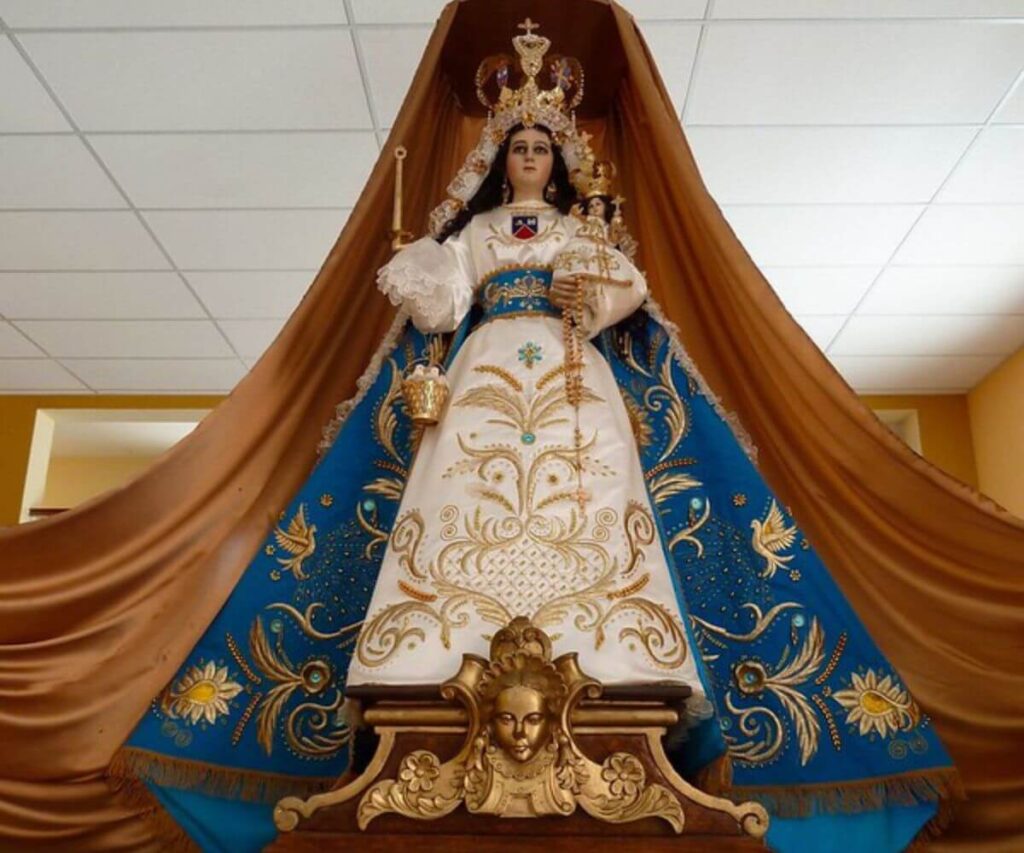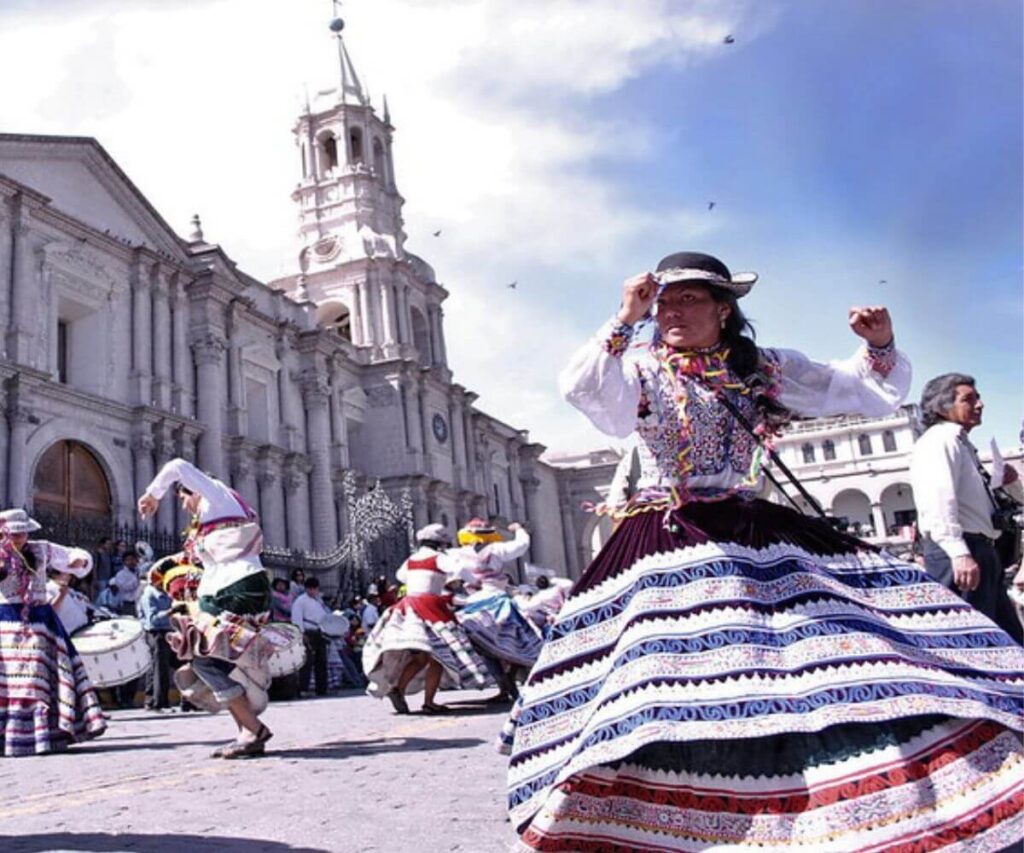Arequipa, "White City", in southern Peru, stands out for its sillar stone architecture and rich history. Over time, its customs and traditions have been influenced by indigenous people, Spaniards, and mestizos, shaping its current identity.
Arequipa is famous for its vibrant festivities such as the Anniversary of its Foundation, Holy Week, Carnival, and the Feast of the Virgin of Chapi, reflecting its religious, cultural, and joyful spirit. These celebrations are moments of unity and tradition for the Arequipeña community.
The Feast of the Virgin of Chapi is celebrated on May 1st and is one of the most significant festivals in Arequipa, attracting thousands of devotees who pilgrimage to the sanctuary. This tradition has its roots in the 16th century when the image of the Virgin survived an earthquake, which was considered a miracle.
From this event, the locals decided to build a chapel in her honor, and since then, the Virgin of Chapi has become the patron saint of Arequipa, venerated by those seeking her protection. Every year, believers walk long distances to reach the sanctuary with offerings and prayers.
During the festival, processions, masses, and special ceremonies are held, where attendees express their faith through songs and devotional acts. In addition, the community takes the opportunity to celebrate its cultural identity with fairs and concerts.
The feast of the Virgin is not only a religious celebration but also a display of the spirit of unity and devotion that characterizes the region, strengthening the bonds among the people of Arequipa.

The Anniversary of Arequipa celebrates the founding of the city in 1540, highlighting its history and culture as the "White City of Peru." The festivities include parades, concerts, food fairs, and folk music competitions, attracting both residents and tourists.
One of the most important traditions is the election of the Queen of the city, and the event also serves as a moment to reflect on the preservation of Arequipa's historical heritage. This celebration strengthens the sense of identity and belonging among the Arequipeña community.
Holy Week in Arequipa is a religious festival full of reflection and spirituality, marked by ceremonies and processions in honor of the passion, death, and resurrection of Christ. One of the most important traditions is the procession of the Lord of the Sanctuary on Good Friday, where the faithful accompany the image of the crucified Christ.
In addition to the processions, cultural events are held, and practices of penance and charity are encouraged. This celebration not only strengthens faith but also highlights the region's gastronomic tradition.
The Arequipa Carnival, celebrated before Lent, is a tradition full of music, parades, and joy. One of its most popular traditions is the "yunza," where participants dance around a decorated tree, symbolizing renewal.
The activity also includes costume contests, concerts, and rituals such as the burial of Ño Carnavalón. It also highlights local gastronomy, such as picantería and cuy chactado, making this event a cultural celebration.
Arequipa stands out for its cultural traditions and dances that reflect its rich and diverse heritage. These customs, from ancient times to today, are an essential part of its identity and heritage, attracting both locals and tourists.

The Wititi Dance, originating from the valleys of Colca and Lares in Arequipa, is a cultural symbol of the region and is considered Cultural Heritage of the Nation. This dance represents the courtship of a young man who, to be with his beloved, disguises himself as a woman at a festival in another town.
The Wititi stands out for its preservation of Arequipa's ancestral traditions, with its movements, music, and clothing. Through this dance, homage is paid to the cultural identity of the region.
Sillar constructions, made from a whitish-gray volcanic stone, are a key element of Arequipa's colonial architecture. This material is abundant in the region and is used in the construction of various structures.
The colonial architecture of Arequipa combines mestizo baroque style, with Spanish and indigenous influences. The buildings are known for their beauty, durability, and stone carvings.
Among the main examples of sillar constructions are the Arequipa Cathedral, the Church of the Jesuits, and the Church of San Francisco. These buildings are not only renowned for their architecture but also for their historical and cultural value.
The Pícaras Coplas of Arequipa are humorous and satirical verses that address everyday and social topics, passed down from generation to generation. They originated during the colonial era as a subtle form of criticism and opinion.
The "pícaras coplas" from Arequipa are humorous and satirical verses that address everyday and social topics passed down from generation to generation; they originated in the colonial era as a discreet way of expressing criticism and opinions.
These popular coplas are recited during festivities and celebrations by improvisers known as "copleros." They stand out for their sharpness and creativity, reflecting the idiosyncrasy of Arequipa.
In the Arequipa region of Peru, religious traditions and pilgrimages form a vital fabric in the culture and soul of its people. These deep-rooted practices are intertwined with history, faith, and ancestral beliefs, giving rise to moving and significant events.
The Pilgrimage of the Virgin of Chapi attracts thousands of believers each year, based on stories of miracles and healings attributed to the Virgin; it is an event symbolizing faith, hope, and devotion, especially in times of difficulty.
Pilgrims, both local and foreign, make a spiritual journey to the sanctuary of the Virgin of Chapi, where they participate in rituals and religious chants. The pilgrimage fosters community and solidarity among the faithful, who share experiences and testimonies.
The Procession of Unburied Bones is an ancestral ritual that honors ancestors and reflects the connection between the living and the dead. It is held on specific dates, aiming to keep the memory of those who have passed alive.
During the procession, participants carry skulls and bones of their loved ones, adorned and venerated with songs, dances, and offerings. This tradition strengthens the identity and cultural continuity of Andean communities, uniting the past and the present.
The customs of Arequipa reflect its cultural diversity and natural wealth, offering both locals and tourists a unique experience. From ancient traditions to modern celebrations, the "White City" continues to captivate those who explore its cultural legacy.
Bullfighting is an important tradition in Arequipa, celebrated during various festivities, attracting locals and tourists. During the event, selected bulls face each other in a prepared arena while the public cheers enthusiastically. Although controversial to some, the local community views it as an expression of identity and respect for tradition.
The Burning of Judas is an activity during Holy Week in Arequipa, symbolizing the triumph of good over evil and the spiritual renewal of Lent. During this event, straw dolls representing Judas Iscariot or other controversial figures are made and burned in an act of purification.
The community gathers around the bonfires, singing and dancing as the dolls burn. This practice not only has religious significance but also social importance, providing an occasion to strengthen unity and local identity.
The Tingo Lagoon, located near Arequipa, is a natural destination surrounded by mountains and vegetation, ideal for outdoor activities. Visitors can enjoy boat rides, observe wildlife, and relax on its shores.
This place is not only a tourist attraction but also sacred to local communities who perform rituals in honor of the spirits of nature.
Here we answer some frequently asked questions about the customs of Arequipa.
In Arequipa, the city's anniversary on August 15th celebrates its Spanish founding with parades, fairs, and cultural events. This celebration highlights the city's history and identity.
Gastronomy is an essential part of local customs, with typical dishes such as rocoto relleno, adobo arequipeño, and chicha de jora forming part of Arequipa's culinary tradition.
The culture of Arequipa is a blend of indigenous, Spanish, and mestizo influences, reflected in its colonial architecture, such as churches and plazas. Music, dance, and festivities are also essential in preserving the city's identity.
Additionally, local crafts and gastronomy, with typical dishes, help convey the cultural life of Arequipa, keeping its ancestral traditions alive.
Arequipa stands out for its natural and urban landscape, with volcanoes like Misti and colonial architecture made of white sillar stone. Known as the "White City," it offers an impressive view with its squares, churches, and cobblestone streets.
Its rich history, culture, and gastronomy, along with its typical dishes, make Arequipa an attractive destination for tourists. The local festivities and traditions also enrich the experience for those who visit.


